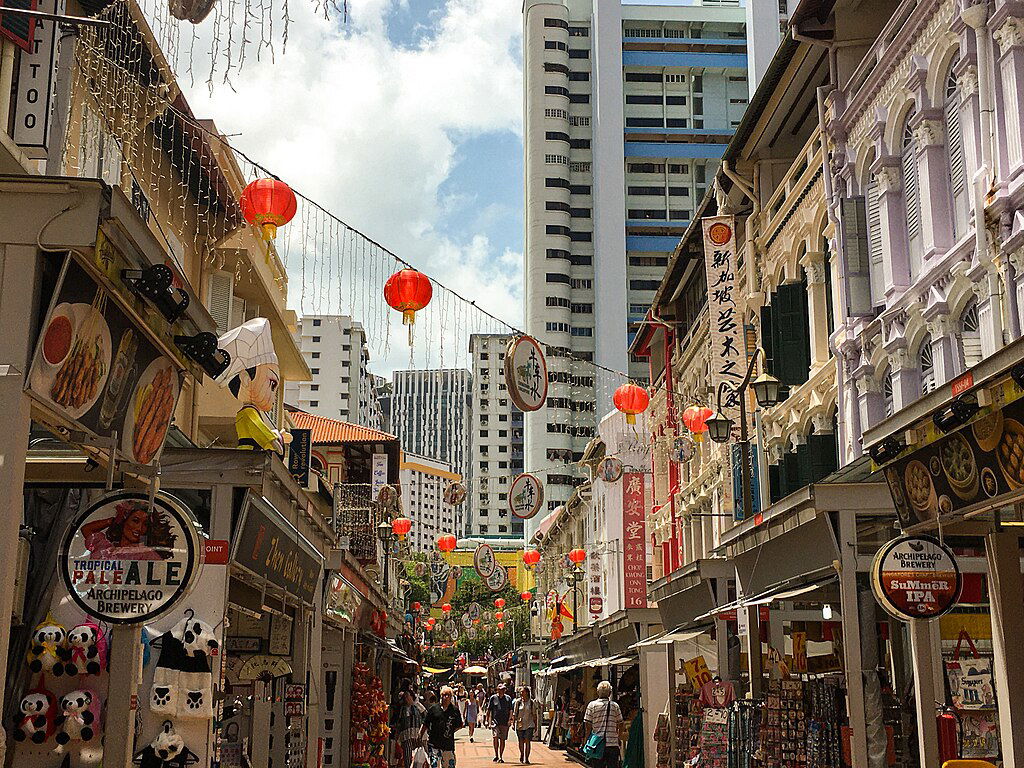Why Is Singapore's Chinatown A Piece of Living History?
Singapore's Chinatown looks like it can be nothing else but another tourist spot—crowded markets, colourful shophouses, and streets filled with the aroma of delectable food. But if you dig deeper, you'd know that it's so much more than a place to shop for souvenirs and a place to grab some good food. Chinatown is a living, breathing piece of Singapore's history, where past and present coalesce in a manner few places can match. It's a destination where old traditions continue to grow and evolve, where cultures blend seamlessly, and where every nook has a tale to tell.

img via wikipedia commons
A Walk Through Time
One of the most striking things about Chinatown is that it has stayed in the past but is still alive today. Walk its streets, and you'll see charmingly restored shophouses—painted bright colours, wooden shutters and detailed facades reminiscent of the past. But venture inside these structures, and you might discover a trendy café, an art studio, or even a modern co-working space. It's the blending of old and new that makes Chinatown so fascinating. While some are stuck in a bygone era, others have adapted to the needs of contemporary living. Herbalists who once peddled cures on wooden barrows now yield to vending machines selling traditional beverages. Restaurants continue to serve staple fare, but they're interspersed between international eateries and hip bars. For those staying at Copthorne King's Hotel Singapore or any other Robertson Quay hotel, and who are not afraid to diverge from tourist paths, there is a wee bit more that Chinatown can offer. Not so much a matter of snapshots of lantern-decked alleys or tearing in for some hasty fare.
Where Cultures and Beliefs Intersect
Chinatown is renowned for its Chinese heritage, but is also a reflection of Singapore's multiculturalism. As soon as you exit the MRT station, you are bombarded by the combination of senses and aromas—Chinese pop music blasting from the street food centres, the smell of freshly roasted pork in the air, and two metres away, a view of a huge Hindu temple in the midst of it all. The Sri Mariamman Temple, the oldest Hindu temple in Singapore, is only one expression of how different cultures blend in this region. Just a walk away is the Buddha Tooth Relic Temple, an icon of reverence and reflection amidst the city's constantly changing soul. These places of worship are icons in themselves—these are throbbing centres of spirituality, where individuals come to pray and find solace.
Architecture That Tells a Story
Every building in Chinatown has a tale to tell. The shophouses with wooden carvings and colourful fronts are witnesses to the early Chinese immigrant existence that brought their businesses and homes here. Some of these buildings go back to colonial times, silent onlookers to Singapore's transformation into a cosmopolitan city. Nostalgia, however, does not lie in Chinatown alone. It is a site where architectural designs meet—old shophouses encircled by humongous skyscrapers, ancient temples side by side with new shopping malls, and green skyscrapers that look like sci-fi fill the urban landscape. Not only pleasing to the eyes, old and new both depict the flexibility of Singapore in progressing without ever allowing its past to overpower it.
A Culinary Adventure Like No Other
If you have to do one thing in Chinatown; eat. The area is a foodie's paradise, where centuries of flavours get blended and reworked into the most incredible dishes. Hawker stalls serve traditional recipes—retro recipes like steam bowls of noodles, perfectly roasted meats, and aromatic rice plates perfected over decades. The cuisine of Chinatown is not only about tradition but also about innovation. New-wave chefs are revolutionising classic dishes, blending old-school flavours with new methods. There are retro bakeries, decades old, experimenting with new fillings, and traditional hawker stalls offering gourmet-styled street food staples.
More Than a Destination—A Living, Breathing Community
Chinatown is not something to view—it's a community that evolves and increases. While tourists do visit to enjoy its vibrant streets and cultural landmarks, it's still a neighbourhood where individuals live, work, and socialise. It's a district that has successfully maintained its past and welcomed new change, proof that tradition is not always better kept in glass cases—it may change, but it can retain the same soul. It's about being somewhere where history is palpable, where cultures blend magnificently, and where each corner holds a tale yet to be uncovered.
